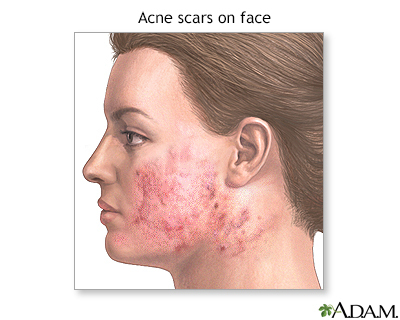Dermabrasion
Definition
Dermabrasion is the removal of the top layers of the skin. It is a type of skin-smoothing surgery.
Alternative Names
Skin planing
Description
Dermabrasion is usually done by a doctor, either a plastic surgeon or dermatologic surgeon. The procedure takes place in your doctor's office or an outpatient clinic.
You'll likely be awake. A numbing medicine (local anesthesia) will be applied to the skin that will be treated.
If you are having a complex procedure, you may be given medicines called sedatives to make you sleepy and less anxious. Another option is general anesthesia, which allows you to sleep through surgery and not feel any pain during the procedure.
Dermabrasion uses a special device to gently and carefully "sand down" the top surface of the skin down to normal, healthy skin. Petroleum jelly or antibiotic ointment is placed on the treated skin to prevent scabs and scars from forming.
Why the Procedure Is Performed
Dermabrasion may be helpful if you have:
- Age-related skin growths
- Fine lines and wrinkles, such as around the mouth
- Precancerous growths
- Scars on the face due to acne, accidents, or previous surgery
- Reduce the appearance of sun damage and photo-aging
For many of these conditions, other treatments can be done, such as laser or chemical peels, or medicine injected into the skin. Talk to your provider about treatment options for your skin problem.
Risks
Risks of any anesthesia and surgery in general include:
- Reactions to medicines, breathing problems
- Bleeding, blood clots, infection
Risks of dermabrasion include:
- Lasting skin color changes with the skin staying lighter, darker, or pinker
- Scars
After the Procedure
After the procedure:
- Your skin will be red and swollen. Swelling usually goes away within 2 to 3 weeks.
- You may feel aching, tingling, or burning for a while. The doctor can prescribe medicine to help control pain.
- If you've had cold sores (herpes) before, your doctor may give you antiviral medicine to prevent an outbreak.
- Follow your doctor's instructions on skin care after you go home.
During healing:
- The new layer of skin will be a little swollen, sensitive, itchy, and bright pink for several weeks.
- Healing time depends on the extent of dermabrasion or size of treatment area.
- Most people can go back to normal activities in about 2 weeks. You should avoid any activity that could cause injury to the treated area. Avoid sports that involve balls, such as baseball, for 4 to 6 weeks.
- For about 3 weeks after surgery, your skin will turn red when you drink alcohol.
- Men who have this procedure may need to avoid shaving for a while, and use an electric razor when shaving again.
Protect your skin from the sun for 6 to 12 weeks or until your skin color has returned to normal. You can wear hypoallergenic make-up to hide any changes in skin color. New skin should closely match the surrounding skin when full color returns.
Outlook (Prognosis)
If your skin remains red and swollen after healing has started, it may be a sign that abnormal scars are forming. Tell your doctor if this happens. Treatment may be available.
People with dark skin are at greater risk of having dark patches of skin after the procedure.
Gallery

References
Monheit GD, Chastain MA. Chemical and mechanical skin resurfacing. In: Bolognia JL, Schaffer JV, Cerroni L, eds. Dermatology. 4th ed. Philadelphia, PA: Elsevier; 2018:chap 154.
Perkins SW, Floyd EM. Management of aging skin. In: Flint PW, Francis HW, Haughey BH, et al, eds. Cummings Otolaryngology: Head and Neck Surgery. 7th ed. Philadelphia, PA: Elsevier; 2021:chap 23.
